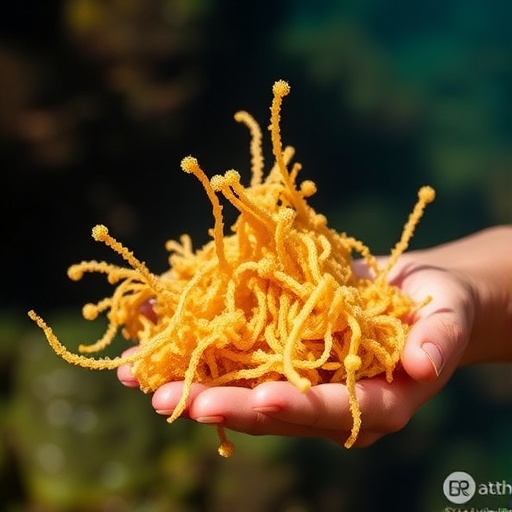In recent years, the global push for sustainable materials has led researchers to explore various biomass sources for their potential as raw materials in the creation of bioactive compounds. One such source, the marine alga Sargassum tenerrimum, is garnering attention for its promising applications in the field of food science and medicine. Zargari and colleagues have undertaken an extensive study to investigate the valorization of this seaweed, specifically focusing on the extraction of bioactive sulphated polysaccharides and their subsequent analysis for techno-functional and biological properties.
Sargassum tenerrimum, a species of brown algae commonly found in tropical and subtropical waters, possesses a unique combination of chemical properties that make it an attractive candidate for bioactive compound extraction. This alga thrives in nutrient-rich aquatic environments, absorbing a variety of minerals and organic compounds from the sea. The biomass generated from Sargassum has historically been overlooked, often viewed as a nuisance in coastal areas. However, Zargari and their team have demonstrated that this byproduct can be transformed into valuable resources with diverse applications.
The extraction process employed by the researchers involves a series of meticulously controlled steps designed to isolate the sulphated polysaccharides efficiently. These compounds are known for their viscoelastic properties, which can enhance the textural qualities of various food products. The study outlines an innovative approach for optimizing the extraction conditions, such as temperature, pH, and time, to maximize yield without degrading the polysaccharides’ bioactivity.
Once the polysaccharides are extracted, their techno-functional properties are evaluated. Techno-functional properties such as emulsifying, thickening, and gelling capacities are critical for food industry applications. The results indicate that the polysaccharides exhibit remarkable emulsifying properties, making them ideal candidates for the development of food emulsions, sauces, and dressings that require stability and texture. Furthermore, the thickening properties contribute to the mouthfeel and viscosity, which are desirable traits in many food formulations.
Beyond their functional properties, the biological activities of the extracted sulphated polysaccharides were also scrutinized. The study highlights their antioxidant activity, which is essential for combating oxidative stress in both food systems and human health. Antioxidants play a crucial role in protecting cells from damage and have been linked to various health benefits, including reduced risk of chronic diseases. The findings suggest that the bioactive polysaccharides derived from Sargassum tenerrimum possess significant potential as natural preservatives, extending the shelf life of food products while promoting consumer health.
Moreover, the researchers delve into the potential health benefits associated with the consumption of these sulphated polysaccharides. Beyond their antioxidant properties, preliminary studies indicate anti-inflammatory and anti-cancer effects, positioning these compounds as valuable ingredients in functional foods and nutraceuticals. The increasing consumer demand for natural and healthier food options further supports the direction of this research, as bioactive compounds derived from marine sources gain popularity.
The valorization process not only highlights the potential of Sargassum tenerrimum for bioactive polysaccharide extraction but also underscores the importance of marine biomass as a sustainable resource. As environmental concerns rise, particularly in relation to plastic pollution and overfishing, harnessing the capabilities of underutilized marine species could provide a pathway towards ecological and economic sustainability. By converting what was once considered waste into valuable bioactive compounds, researchers like Zargari et al. are contributing to the development of a circular economy that benefits both the environment and industry.
The implications of this research extend beyond food applications. The extracted polysaccharides could also find their way into cosmetics and personal care products due to their skin-conditioning properties. As the beauty industry tilts increasingly toward green and sustainable ingredients, the potential use of polysaccharides from Sargassum offers a fascinating avenue for product development.
Zargari’s work embodies a growing trend in scientific research: the intersection of sustainability, health, and innovation. By uncovering new possibilities in the valorization of marine biomass, this research paves the way for further investigation into other potential applications of Sargassum tenerrimum and similar species. It also encourages collaboration between academia, industry, and government entities to foster a more sustainable approach to resource management in marine environments.
Overall, the study serves as a compelling example of how traditional waste materials can be repurposed into high-value products through innovative scientific methods. As the world faces an increasing array of challenges related to food security, health, and environmental sustainability, research like that conducted by Zargari et al. emphasizes the importance of exploring and utilizing alternative resources. The potential applications of sulphated polysaccharides extracted from Sargassum tenerrimum are significant not only for their immediate commercial viability but also for their role in promoting an eco-friendly future.
In conclusion, Sargassum tenerrimum emerges as a beacon of hope within the realm of bioactive compounds, illustrating that what lies beneath the ocean waves can lead to meaningful advancements in health and sustainability. As research in this area progresses, the implications of such studies were expanded further into real-world applications. The valorization of Sargassum biomass represents a paradigm shift in how we view marine resources, transforming perceptions of waste into opportunities for innovation and sustainable development.
By highlighting the multi-faceted benefits of Sargassum tenerrimum and its polysaccharides, the study by Zargari et al. not only advances scientific understanding but also connects the dots toward a more sustainable and health-oriented future. As we continue to explore the depths of our oceans, it is likely that other untapped resources await discovery, with the potential for transformative impacts across various sectors.
Subject of Research: Valorization of Sargassum tenerrimum Biomass for Bioactive Compound Extraction
Article Title: Valorization of Sargassum tenerrimum Biomass for the Extraction of Bioactive Sulphated Polysaccharide and Evaluation of Its Techno-functional and Biological Properties
Article References:
Zargari, A., Jahanbin, K., Abbaszadeh, S. et al. Valorization of Sargassum tenerrimum Biomass for the Extraction of Bioactive Sulphated Polysaccharide and Evaluation of Its Techno-functional and Biological Properties.
Waste Biomass Valor (2025). https://doi.org/10.1007/s12649-025-03317-w
Image Credits: AI Generated
DOI:
Keywords: Sargassum tenerrimum, bioactive polysaccharides, sustainable biomaterials, valorization, antioxidative properties, food science.
Tags: biological properties of marine extractsbrown algae in medicinecoastal biomass utilizationeco-friendly raw materials for bioactive compoundsextraction of sulphated polysaccharidesfood science applications of seaweedmarine alga extraction techniquesnutrient-rich aquatic resourcesSargassum tenerrimum bioactive polysaccharidessustainable marine biomass researchtechno-functional properties of polysaccharidesvalorization of Sargassum seaweed






